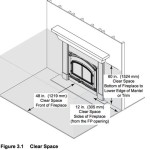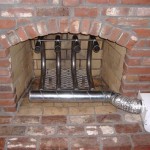Wall Above Fireplace Gets Hot: Understanding the Causes and Solutions
A frequently encountered concern in homes with fireplaces is the noticeable heating of the wall directly above the firebox. While fireplaces are designed to generate warmth, excessive heat transfer to surrounding structural elements, such as the wall above, can indicate underlying issues ranging from inefficient fireplace design to improper installation or maintenance. Understanding the causes behind this phenomenon is crucial for ensuring the safety and efficiency of the fireplace system and preventing potential hazards like fires or heat damage to the home's structure.
The temperature of the wall above the fireplace is influenced by a confluence of factors, each contributing to the overall heat transfer. These factors include the fireplace's construction, the effectiveness of its insulation, the type and intensity of the fire burned, and the presence of any obstructions within the chimney or flue system. An improperly installed or maintained fireplace is inherently more likely to generate excessive heat that radiates outward, affecting the surrounding wall.
This article will explore the various reasons why the wall above a fireplace might become excessively hot, focusing on the underlying mechanisms responsible for heat transfer and potential solutions to mitigate the problem. It will delve into aspects such as fireplace design flaws, insulation deficiencies, chimney issues, and operational practices that contribute to the heating of the wall. The aim is to provide homeowners with a comprehensive understanding of the problem and practical guidance in addressing it.
Inefficient Fireplace Design and Construction
The design and construction of the fireplace itself play a pivotal role in determining the extent to which the wall above it heats up. Older fireplaces, in particular, often lack modern insulation standards, making them more susceptible to heat transfer to surrounding materials. Traditional masonry fireplaces, while aesthetically pleasing, can be inherently inefficient due to their large thermal mass and tendency to radiate heat in all directions, not just into the room.
The firebox's construction is critical. If the firebox is made of thin or uninsulated material, heat will readily conduct through the walls and into the surrounding structure. Modern fireplaces often incorporate refractory materials, such as firebrick or cast iron, which are designed to withstand high temperatures and radiate heat more efficiently. The absence of these materials or their degradation over time can lead to excessive heat transfer to the surrounding wall.
Furthermore, the throat of the fireplace, the area directly above the firebox where the smoke exits into the chimney, is another potential source of heat loss. If the throat is not properly designed or sealed, hot gases and flames can escape into the surrounding cavity, directly heating the wall above. A well-designed fireplace should have a properly sized and sealed throat, along with a smoke shelf that helps to prevent downdrafts and further reduce heat loss.
The proximity of combustible materials to the firebox and chimney also significantly impacts heat buildup. Building codes dictate minimum clearances between the fireplace and combustible materials like wood framing. Failure to adhere to these clearances during construction can result in excessive heat transfer to the surrounding wall and increase the risk of fire. This is especially crucial in older homes where building codes may have been less stringent.
Insulation Deficiencies and Heat Transfer Mechanisms
Adequate insulation is essential to prevent excessive heat transfer from the fireplace to the surrounding wall. Insulation acts as a barrier, reducing the rate at which heat conducts through the wall and minimizing the temperature increase. The type and quality of insulation used, as well as its proper installation, are crucial factors in mitigating heat transfer.
Poor or missing insulation around the firebox and chimney is a common cause of the wall above the fireplace getting hot. Over time, insulation can degrade due to moisture, pests, or physical damage, reducing its effectiveness. In some cases, insulation may never have been installed properly during construction, leaving gaps or voids that allow heat to readily escape.
Heat transfer occurs through three primary mechanisms: conduction, convection, and radiation. Conduction involves the transfer of heat through direct contact, such as heat moving through the brick and mortar of the fireplace. Convection involves the transfer of heat through the movement of fluids, such as hot air rising within the chimney or the surrounding cavity. Radiation involves the transfer of heat through electromagnetic waves, such as the infrared radiation emitted by the fire itself.
Insulation works by reducing the rate of heat transfer through conduction and convection. By creating a barrier with low thermal conductivity, insulation slows down the movement of heat from the fireplace to the surrounding wall. Properly installed insulation also helps to prevent air leaks, which can contribute to convective heat transfer. In addition, reflective insulation materials can reduce the amount of radiant heat that is absorbed by the wall.
Chimney Issues and Obstructions
The chimney plays a crucial role in venting hot gases and smoke away from the fireplace and out of the house. Any obstructions or inefficiencies within the chimney system can impede the proper flow of gases, leading to increased heat buildup within the fireplace and potential heat transfer to the surrounding walls. Regular chimney inspections and maintenance are essential to identify and address these issues.
Creosote buildup is a common problem that can significantly impact chimney performance. Creosote is a flammable substance that forms as a byproduct of incomplete combustion in the fireplace. Over time, creosote can accumulate on the inner walls of the chimney, reducing its diameter and restricting airflow. This restriction can cause hot gases to back up into the fireplace, increasing the temperature of the surrounding walls and potentially creating a fire hazard.
Chimney blockages, such as bird nests, leaves, or other debris, can also impede airflow and lead to heat buildup. These obstructions prevent the efficient venting of hot gases, causing them to linger within the fireplace and increasing the temperature of the surrounding structure. A regular chimney sweep can remove these blockages and ensure proper airflow.
Additionally, cracks or deterioration in the chimney liner can allow hot gases to escape into the surrounding masonry and potentially ignite nearby combustible materials. The liner is a protective barrier that prevents hot gases from directly contacting the chimney structure. A damaged or deteriorated liner can compromise this protection and increase the risk of fire. Regular inspections can reveal cracks or other damage to the liner, allowing for timely repairs or replacement.
Improper damper operation can also contribute to heat buildup. A damper that is not fully open can restrict airflow, causing hot gases to back up into the fireplace and increase the temperature of the surrounding walls. A damper that is not properly sealed when the fireplace is not in use can also allow cold air to enter the house, increasing heating costs.
In conclusion, the heating of the wall above a fireplace is a multifaceted issue stemming from factors such as inefficient fireplace design, insulation deficiencies, and chimney problems. Addressing these issues requires a thorough understanding of the underlying causes and implementing appropriate solutions such as upgrading insulation, ensuring proper chimney maintenance, and potentially modifying fireplace construction. Regular inspections and professional assessments are essential to ensuring the safety and efficiency of the fireplace system.

Can I Mount My Tv Above The Fireplace
How To Prevent A Wall Mounted Tv Above Fireplace From Getting Hot Quora

Recessed Wall Above Fireplace

Can You Put A Tv Over Fireplace Direct Fireplaces

Safely Mount A Tv Above An Electric Fireplace Touchstone Home S Inc

ᑕ❶ᑐ How High Should A Mantel Be Above An Electric Fireplace

Diy Fireplace Makeover Wood Slat
How To Prevent A Wall Mounted Tv Above Fireplace From Getting Hot Quora

How To Hide Tv Wires Above A Fireplace When You Can T Go Through The Wall Homes I Have Made

Tips On Hanging A Tv Above Fireplace Armand S Discount Inc
Related Posts








